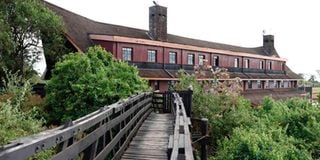Return to The Ark

They say that crossing paths with a black cat is unlucky, but we were very fortunate to spot one in the Aberdares last weekend. It was a lone black serval, high up in the central moorlands of the park.
Against the silvery-green backdrop of tussock grass, its pitch-black coat was impossible to miss. It glanced back at us as we inched closer before darting across the road and disappearing into a nearby thicket.
That serval was a stunning example of an animal with melanism – a genetic condition that manifests as an overproduction of black pigment or melanin. There are many known examples of melanism among felines around the world and recorded sightings within Kenya have increased in recent years – such as the well-documented camera trap captures of black leopards in Laikipia.
Globally, the condition seems to be more prevalent in forested, high-altitude habitats (such as the dense forests of South and South-East Asia), where black coats can provide more camouflage. There is also a theory that the darker colour can help with temperature management in cold, high-altitude environments like the moorlands of the Aberdares.
We were on the way to The Ark when we had our lucky serval encounter. The other Ark guests would have been enjoying a lavish lunch at the Aberdare Country Club at the time, but we opted to spend half the day exploring the landscapes in the south of the park.
Arriving through the Matubio West Gate, we first crawled along the rocky track to the top of the magnificent Karuru Waterfall. That view – out towards the misty valley, and the 300-metre tall Gura Falls on the opposite ridge – is up there with the very best that Kenya has to offer.
Chania Falls
From there, we headed to the shorter, but equally impressive, Chania Falls. One of the unique aspects of the Aberdares, compared to other KWS parks, is the relative freedom you have to get out of your car and explore on foot. At each of the waterfalls, you can stretch your legs along well-maintained paths across the moorlands or through the forest.
After a picnic lunch, we snaked our way down to the lower salient section of the park, passing troops of colobus and Sykes’ monkeys in the trees. We pulled into The Ark just as the other guests arrived in time for afternoon tea.
I’ve probably stayed at The Ark more than anywhere else in Kenya over the past 30 years, but the novelty of this unique lodge still hasn’t worn off. Before this trip, if you would asked me to describe whether the rooms were en suite, or if the food was any good, I would have struggled to give you an answer.
Waterhole
Ninety per cent of my time there has been spent glued to the window above the waterhole, scanning the forest edge at night to catch a glimpse of a hyena or a leopard. It’s not a five-star hotel, but that’s never mattered to me; the wildlife outside is its main attraction.
As we enjoyed a drink in the lounge, I recognised The Ark’s ‘Captain’, Charles Mathenge. He told me he had managed the lodge for 18 years, and that its current owners, Marasa Africa, had recently refurbished it. Like many properties around Kenya, the lodge had struggled through Covid, but guest numbers are now picking up.
Charles was also very positive about the park’s wildlife numbers, particularly the critically-endangered mountain bongo. He said camera trap footage could indicate that there are 20 bongos within a 7km radius of the lodge. They weren’t confident enough yet to venture to the waterhole for a drink that night, but it may not be long before they do.
If you would like to book a night at The Ark, too, head to www.thearkkenya.com, or email [email protected].





